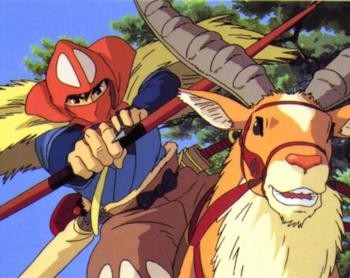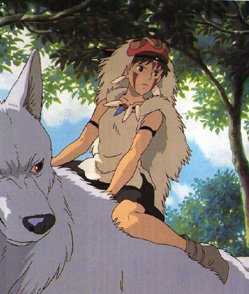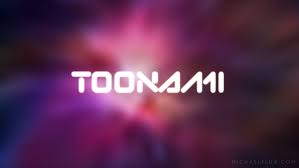Hayao Miyazaki’s, Princess Mononoke (
Mononoke-hime), is one of those films that truly captures the art and power of good storytelling in animation. When I first saw
Princess Mononoke in 1999, I was blown away by the stunning animation and complexity of the story in the film.
Princess Mononoke, in a sense, was the first Japanese animated (anime) film, I ever saw that touched me deeply. Other anime films like
End of Evangelion (directed by
Hideaki Anno) and
Ghost in the Shell (directed by
Mamoru Oshii), made my head hurt or left me confused. Don’t get me wrong, I like both
End of Evangelion and
Ghost in the Shell, but I think
Princess Mononoke is a better film.
Today,
Princess Mononoke, in my opinion, is one of the best animated films of all time because of the amazing visuals and complexity of the characters in the story.
Princess Mononoke is about a prince named
Ashitaka (see picture below) who journeys to the west to find a cure for a curse he receives, while fighting a rampaging boar god called
Nago. When examining Nago’s remains, the village spiritual elder, discovers an iron bullet in the remains and tells Ashitaka to head west to make inquiries into the origins of the bullet. After cutting his hair (this is a sign that he is dead to his village) and saying goodbye to his younger sister, Ashitaka leaves with his pet red elk called
Yakul. Along the way, Ashitaka runs into a monk named
Jigo, who informs him that the god of the forest (referred to as, the
Forest Spirit or Shishigami) in the western mountains could probably cure him of his curse.

Meanwhile, in a town called
Iron Town, the citizens of the town are in a conflict between the spirits and gods, living in the surrounding forest. The reason the spirits and gods are upset with the citizens of Iron Town is because they are cutting down trees and clearing land for smelting iron to make guns and bullets. The chief antagonist against the citizens of Iron Town is the wolf goddess,
Moro and her children, including the human girl,
San (referred to as, Princess Mononoke). While an entourage of townspeople from Iron Town are carrying rice back to the town, Moro, San (see picture below), and Moro’s two sons attack them. The citizens, under
Lady Eboshi (the leader of Iron Town) fight back, but they lose a few down the side of the mountain, and Moro ends up wounded from an iron bullet.

The next day, Ashitaka discovers a pair of survivors from the attack in the river and he pulls them out; he also spots San, treating Moro’s wounds. Ashitaka tries to talk to San, but she and Moro depart without speaking a word. Learning from the survivors that they come from Iron Town, Ashitaka takes them through the forest, encountering spirits called
kodamas along the way. Ashitaka is treated hospitably by the citizens of Iron Town and Lady Eboshi gives Ashitaka a tour of the smelting factories, which are operated by former prostitutes and lepers. Later that night, San makes a raid on Iron Town to kill Lady Eboshi; she engages in a battle with Lady Eboshi but both women are knock out by Ashitaka. Ashitaka decides to take San out of the town, but the citizens try to stop him; they are unsuccessful.
Ashitaka, who is suffering from wounds and the curse’s power, collapses on the ground. San awakens at this point and demands to know why Ashitaka saved her; his answer angers and confuses her. San decides to take Ashitaka to the Forest Spirit to heal his wounds, which he does, but the curse still remains. While San is taking care of Ashitaka, a number of boar gods led by Okkoto arrive on the scene and are outraged that San has brought him here, but
Okkoto spares Ashitaka’s life, provided Ashitaka never comes upon his presence agan. Curious, as to why the boars are gathering in such large numbers, Okkoto reveals that he and his brethren are going to attack the people of Iron Town.
While, San is caring fcr Ashitaka, Lady Eboshi prepares for the boars and is also approached by Jigo, to aide him in retrieving the head of the Forest Spirit for the emperor; it is believed that the head of the Forest Spirit brings immortality to those who possess it. The boars launch their attack, but a great deal of them are killed by exploding traps set up by Lady Eboshi and her men. Okkoto is wounded by an iron bullet and starts to transform into a rampaging demon like Nago was. San, who went to aide the boars, gets caught in Okotto’s snought trying to prevent his rampage. Moro attacks Okkoto to get her daughter back and the Forest Spirit enters the scence and takes Moro’s and Okotto’s life away, but leaves San alone. Ashitaka, soon arrives with the help of one 0f Moro’s children, and aides in cleaning demon tentacles off of San.
Lady Eboshi, during this time, waits for her chance to shoot the Forest Spirit’s head off and give to Jigo. Her chance comes when the Forest Spirit starts to transform into the
Nightwalker (see picture below); the Forest Spirit by day looks like a strange deer-like creature, but at night he becomes the Nightwalker. Lady Eboshi shoots the Forest Spirit’s head off and gives it to Jigo, but the Nightwalker’s (Forest Spirit’s) body turns into a ooze of death and destruction. Ashitaka and San vow to get it back and pursue Jigo and his men. The citizens of Iron Town evacuate the town because the headless body of the Nightwalker is heading their way destroying everything in its path. Ashitaka and San confront Jigo and get the head back; they give it to the headless body of the Nightwalker and it falls into the lake. As the body falls, the surrounding area begins to see new signs of life and Ashitaka’s curse is lifted. Realizing her mistakes, Lady Eboshi promises to make a new and improve, Iron Town. Both Ashitaka and San love each other, but San still harbors anger and resentment towards the citizens of Iron Town. Ashitaka decides to help with the reconstruction and whenever, he has free time, he promises to visit San in the forest. A kodama is seen at the end of the film, which symbolizes that the forest will become healthy again.

Overall, Princess Mononoke, is not your typical love story nor does it have any real clear-cut villain, though you can make the argument that Lady Eboshi or Jigo is a villain. Ashitaka’s and San’s love for each other is a little more realistic and complicated, which in my opinion makes the film more appealing, than a Disney love story because in real life, love is complicated and rarely does it end with everybody happy and satisfied. The same principle can be applied to the idea of a main villain in films. In Princess Mononoke, Lady Eboshi could be considered an antagonist, but she is portrayed, as a compassionate person to her citizens. An example of this occurs, when Ashitaka finds out that Lady Eboshi provides care and work to lepers and former prostitutes. Jigo fits a better profile because of his greed, but he does help Ashitaka out, towards the beginning of the film, by providing some food to him. Princess Mononoke takes a more realistic approach to people’s motives and behaviors than Disney films because not all people’s motives and behaviors are black and white; instead, they are generally grey and unclear. In the end, Princess Mononoke, is a wonderful film and I recommend it to those who love animated films because of the amazing visuals and complexity of the characters in the story.





